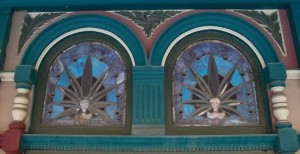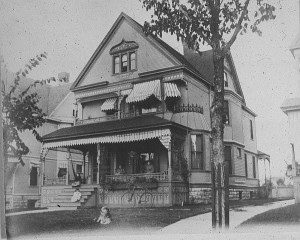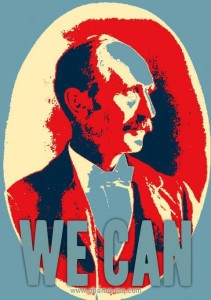
Welcome to the
Healy Project
Join us on Facebook
Send us an Email
Big Win for Healy Block Residents: Revised I-35W Expansion Plan
Great news for Healy’s most famous Queen Anne houses: On Monday evening, March 23rd, at a meeting held by Hennepin County and the City of Minneapolis with residents of the Healy Block Historic District, the proposed sound wall was defeated by unanimous vote among those residents present. In addition, a new proposed design for the I-35W expansion was presented and approved. Monday’s win for the Block is an inspiration for the preservation community: an example of how historic district residents can triumph during a long and challenging political process.
Plans for expanding and redesigning I-35W at the 31st Street exit have been in the works for a long time. Since the early 1990s, various plans have come and gone, representing serious threats to the Healy Block. In their current manifestation, expansion plans were introduced more than four years ago. Negotiation and discussion between the various government entities (federal, state, county and local) and the Block residents have been going on since then. (See post Threats to Healy Houses Renewed) Over a year ago Block representatives met with MNDOT commissioner Charles Zelle to work out some of the issues with the design. The new design and the nixing of the sound wall represent a significant win for livability of the residents on the Block and the future preservation of these historic houses.
David Piehl, who owns and lives in the J.B Hudson House on the Block, explains why eliminating the sound wall from the expansion plans is important: “A wall would be ugly, and the snow storage requirements for the freeway would mean the wall would be 10 feet closer to our homes than it currently is, in addition to being 20 feet high on top of the already-high embankment. Furthermore, the improvement in noise levels was projected to be around 5 decibels, which is not nearly significant enough for us to want to make the other sacrifices the wall would require.”
After the vote on the sound wall, discussion turned to the design of the off-ramp. Residents previously selected a design with a single-lane ramp, separated from Second Avenue by a median. However, the Federal Highway Administration vetoed it as “fatally flawed” due to lack of “storage.” That left another option which was very similar, but had a two-lane ramp.
At the meeting Block residents David Piehl, Ioannis Nompelis, and Pete Holly fought hard to keep the pavement and traffic as far from the historic houses as feasible. Residents recognize that Second Avenue on the 3000-3100 blocks serves three purposes–as a residential street, an off-ramp, and frontage road.
On Monday project organizers presented a modified design that has the ramp starting as single lane, then widening to two. They also widened the median separating Second Avenue from the ramp to 12 feet by taking a portion of the embankment. As Piehl reports, Block residents “are OK with this because it moves green space closer to our homes and the ramp further away. We wanted the median to be wide enough to be planted, so we can plant a visual screen between Second and the ramp, and we got that. A visual screen will also be re-planted on the embankment. The proposed median runs all the way to 31st Street. Second Avenue becomes a single lane with parking, but entirely separate from the ramp south of 31st. Even better, Second at 31st will be ‘right turn only’ due to adding 20 feet of boulevard space in front of the two homes on the 3000 block—which again moves traffic away from those homes, improving livability. The ‘right turn only’ lane reduces the appeal of 2nd Ave as a ‘frontage road’. The upshot is that Second Avenue will be a single lane residential street separated from the ramp by a 12-foot-wide, planted median.”
The miracle is that after four years of negotiating and fighting with the various entities involved in the I-35W expansion, residents of the Healy Block finally got nearly everything they asked for, short of moving the ramp. As Piehl says, “It is amazing to think that they started with bringing the freeway 30 feet closer, and a massive retaining wall–and we got them to a place where the plan is an improvement over what currently exists!”
This is a truly remarkable win for preservation in Minneapolis. Thanks go to a talented city planner, Jeni Hager, who diligently designed, re-designed, and re-designed again to ensure that the current proposal satisfied residents’ aesthetic and livability concerns as well as state and federal requirements. Many thanks also to supportive City Council members Elizabeth Glidden and Alondra Cano for their leadership. And finally, thanks and congratulations to David Piehl, Ioannis Nompelis, Pete Holly, John Cuningham (who worked for moving the ramp) and other Block residents who persevered and made it happen.
and did!
T.B.
 |
| 3139 Second Ave. S, the second house Healy built (1886, $3,500) |
To receive notices about future tours and events, e-mail info@healyproject.org.
+ + + + + + + + + +
The Healy Project is celebrating its incorporation as a nonprofit with a tour of the Healy Block Historic District on Sunday, November 10th.
 |
| The Rea House in the Healy Block Historic District (1890, $5,000) |
Motorists exiting northbound I-35W at Lake Street can’t help but notice the Queen Anne houses on Second Avenue, arguably the best known Victorian houses in Minneapolis. These fanciful survivors from a bygone era were designed and built by Theron Potter Healy, Minneapolis’s premier master builder. The entire west side of the Second Avenue block was wrecked in the 1960s during freeway construction. Over the years, fires, poor maintenance and redevelopment have taken others.
 |
| Healy’s signature double-arch windows. |
Built between 1885 and 1898, these surviving houses, listed in the National Register of Historic Places, have endured thanks to the efforts of a small, but dedicated community. On Sunday, November 10th, the Healy Project is offering a different kind of home tour showcasing the community that has served as advocate for the houses of the Healy Block Historic District (3100 block of Second and Third Avenues).
The Healy Project’s inaugural tour aims to highlight and support the efforts of this community. Tourgoers will not only get the usual background into the houses’ architecture and history, but also background on the economic, cultural, and political forces affecting their past and future. Experts on real estate, community action, and historical research will talk about architectural preservation in the contemporary, living city.
 |
| 1890’s photo of the J.B. Hudson House (1890, $6,000) |
Preview of tour attractions: Background about the history of the Block and the struggles of homeowners in the neighborhood. The context of the Block in the Central neighborhood. A look at so-called “Undercover” Healy block (3200s Second Avenue), contrasting the houses there with the protected houses in the historic district. Healy homeowners’ success at saving other houses on adjoining blocks from demolition. An explanation of how a large Healy carriage house was lifted and replaced on its foundation. A look inside three early Healy-designed Queen Annes (built 1886, 1890 and 1891) on the Block. Information about a MnDOT plan that seriously threatens the entire Block. And more!
 |
| Theron Potter Healy, King of the Queen Anne |
Registration is required to tour house interiors.
Tour-goers should assemble in front of 3139 Second Avenue South at 1 p.m. on the 10th. If you would like to see the interior of 3139, come earlier. Doors open at 12:15 p.m. A $10 donation to the Healy Project is suggested.
 |
| Fishscale shingles on the gable end of 3139 Second Ave. |



